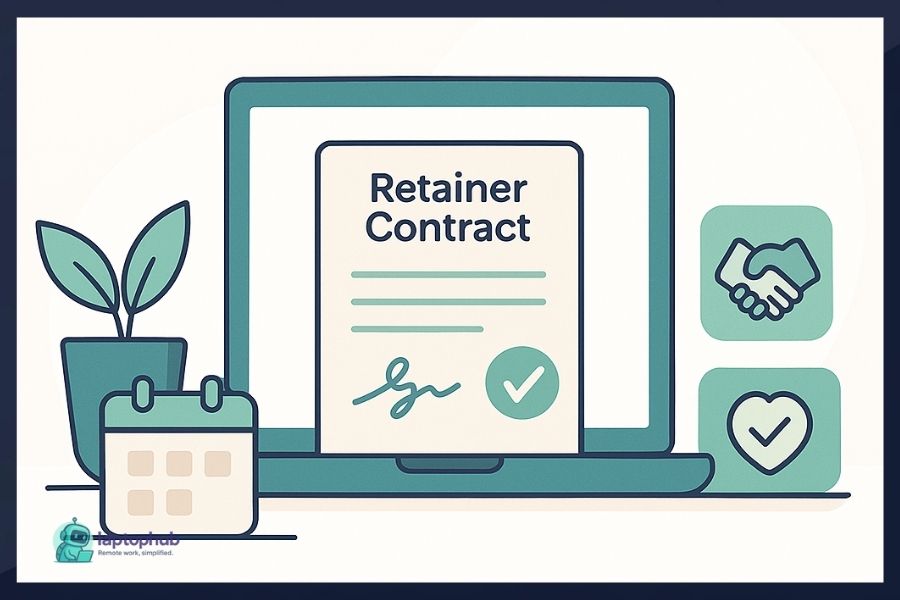Hiring and firing, chasing invoices, starting from scratch—too often, business relationships feel like a revolving door. But what if you could lock in dependable support and eliminate the stop-start cycle for good? Understanding what a retainer contract really offers can shift how you manage creative, technical, or strategic work, turning chaos into clarity and short-term wins into lasting progress.
💡Key takeaways:
- A retainer contract is a recurring service agreement that provides clients with ongoing access to a provider’s expertise.
- It creates long-term value for both sides by offering predictable payments and priority service.
- Different types of retainers—time-based, service-based, access-based, and hybrid—suit different business needs.
- A well-structured retainer agreement must clearly define scope, deliverables, payment, and cancellation terms to avoid misunderstandings.
What Is a Retainer Contract?
A retainer contract is an agreement where a client pays a service provider a recurring fee—usually monthly—for ongoing access to their time, services, or expertise.
Instead of starting fresh with a new project every time, a retainer creates a steady working relationship. It offers the client prioritized service and stability, and gives the provider a predictable income stream.
Retainers are especially common in industries like:
- Digital marketing
- Graphic design
- Public relations
- IT support
- Copywriting
- Legal and consulting services
🖥️Also read: Best Remote Job Niches in 2025 for High-Paying, Future-Proof Careers
At its core, a retainer contract is about building a long-term partnership rather than completing one-and-done tasks.
What makes a retainer different?
Let’s compare a retainer to other common types of work arrangements:
| Model | Payment Method | Duration | Relationship Type | Typical Use Case |
|---|---|---|---|---|
| One-off Project | Lump sum | Fixed | Short-term | Website build, one campaign |
| Hourly | Per hour | Flexible | Task-based | Ad hoc consulting or edits |
| Retainer | Monthly fee | Ongoing | Relationship-based | Monthly content, recurring design |
The main difference is commitment. A retainer contract sets a rhythm. Instead of starting from scratch each time, both parties work from an established understanding.
Types of retainer agreements
Retainer setups can vary based on the nature of work and business goals. Here are the most common formats:
1. Time-based retainer
The client pays for a set number of hours each month (e.g., 20 hours of graphic design).
- Pros: Easy to scale. Client knows how much time they’re paying for.
- Cons: If work exceeds time limits, additional fees apply.
2. Service-based retainer
Client receives specific services on a recurring basis—like four blog posts, 10 social media graphics, or monthly performance audits.
- Pros: Ideal for content marketing, SEO, or managed services.
- Cons: Can be rigid if the client’s needs shift frequently.
3. Access-based retainer
Client pays to have the provider on standby, even if no specific deliverables are required.
- Pros: Common in law, PR, and executive consulting. Ensures quick response.
- Cons: May not always be used to the fullest.
4. Hybrid retainer
Mix of the above. For example, 15 hours monthly plus three deliverables and a strategy call.
- Pros: Tailored to complex client needs.
- Cons: More complicated to track and manage.
Why retainers work for clients
From the client’s point of view, retainers remove guesswork. Here’s why companies often prefer them:
1. Faster turnaround times
Retainer clients typically get bumped to the front of the line. There’s less onboarding and more doing.
2. Strategic alignment
Working with the same provider monthly means they learn your business, tone, goals, and workflows. Over time, they deliver better work with less back-and-forth.
3. Predictable billing
You know what you’re paying every month. No surprise invoices or hidden charges.
4. Consistency
From brand voice to design quality, working with one consistent partner helps create a coherent customer experience.
5. Priority support
Need something urgent? You’ll likely get a faster response compared to one-time clients.
Why retainers work for freelancers and agencies
Freelancers often live in the feast-or-famine cycle. Retainers help break that.
1. Reliable income
Knowing you have $3,000 or $6,000 coming in each month lets you budget, plan vacations, and sleep better at night.
2. Better time management
Instead of juggling 10 one-off jobs, you can serve three to five committed clients more deeply and effectively.
3. Creative stability
Retainers allow providers to focus on quality and long-term results instead of quick wins.
4. Reduced admin work
Fewer proposals. Fewer new contracts. More time doing the actual work you’re paid for.
Must-have elements in a retainer contract
A vague retainer agreement is a recipe for misunderstandings. A well-written contract covers:
• Scope of work
Detail exactly what’s included. Is it 10 social posts, two strategy calls, or unlimited email support?
• Deliverables or hours
Define the amount of work. Be specific about limits and expectations.
• Payment terms
State the amount, billing frequency, and late fee policies. Most providers ask for payment upfront.
• Communication guidelines
Set rules for meetings, turnaround times, and response expectations.
• Rollover or expiration of work
If the client doesn’t use all hours, do they expire? Roll over? Get refunded? Be clear.
• Termination terms
How can either party end the agreement? Is 14 or 30 days’ notice required?
• Ownership and rights
Specify who owns the work created under the retainer and how confidential data is handled.
How to set up a retainer (step-by-step)
Whether you’re a freelancer proposing a retainer or a business setting one up with a provider, here’s how to do it right:
Start With a Trial Project
One-off jobs build trust and help both parties understand how they work together.
Identify Recurring Needs
If a business regularly needs design, writing, SEO, or maintenance—those tasks are perfect for a retainer.
Define Value Clearly
Both sides should understand the return on investment. For example: “This $2,000/month retainer covers weekly blog content that supports your SEO goals.”
Set Pricing and Packages
Create simple, tiered packages if needed. Example:
- Starter: $1,000/month for 10 hours
- Pro: $2,000/month for 25 hours
- Premium: $3,500/month for 40 hours + reporting
Draft and Sign the Agreement
Use plain language. Get it signed. Use tools like HelloSign, DocuSign, or Adobe Acrobat.
Track Work and Review Regularly
Use Trello, Asana, or Notion to track progress. Revisit scope and goals monthly or quarterly.
Real-world examples
✅ Example 1: SEO Consultant
A startup hires an SEO expert on a $2,500/month retainer. Each month, they get:
- 2 strategy calls
- 4 blog posts
- 1 site audit
- Monthly keyword tracking report
The startup doesn’t need to rehire monthly, and the consultant knows what’s expected.
✅ Example 2: Legal Services
A small business pays $1,000/month for legal counsel. They get unlimited quick questions via email, plus contract reviews and one meeting a month.
Instead of scrambling for legal help, they get peace of mind and consistent support.
Retainer Contract Template (Simplified)
Here’s a short template you can customize:
Retainer Agreement Between [Client] and [Service Provider]
- Start Date: [Insert date]
- Monthly Fee: $[Insert amount]
- Scope: [Insert detailed list of services or hours]
- Billing: Invoice sent on [date]; due within [X] days
- Rollover Policy: [Yes/No; state terms]
- Termination: Either party may cancel with [X] days’ notice
- Intellectual Property: Client owns all deliverables after payment
- Confidentiality: All discussions and data are confidential
Signed by both parties.
FAQs
A retainer contract is an agreement where a client pays a recurring fee to secure ongoing access to a freelancer’s or service provider’s time and skills.
Businesses needing consistent services—like marketing, legal advice, or content creation—and freelancers seeking stable income both benefit from retainer contracts.
Retainers provide ongoing work and payments, while project contracts are one-time engagements with a clear end.
That depends on the agreement—some contracts allow hours to roll over, while others expire at the end of each month.
Yes, most retainer contracts include a notice period that allows either party to end the agreement with advance written notice.
Final thoughts
A retainer contract isn’t about locking someone in—it’s about showing up with consistency, clarity, and mutual respect. When done right, it becomes the foundation for deeper work, smarter strategy, and a steady rhythm that both freelancers and businesses can count on to grow with confidence.





